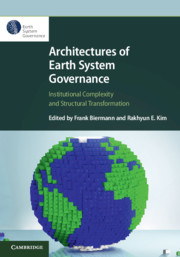Book contents
- Architectures of Earth System Governance
- Series page
- Architectures of Earth System Governance
- Copyright page
- Contents
- Contributors
- Acknowledgements
- 1 Architectures of Earth System Governance
- Part I The Building Blocks
- 2 Intergovernmental Institutions
- 3 International Bureaucracies
- 4 Transnational Institutions and Networks
- 5 Institutional Architectures for Areas beyond National Jurisdiction
- Part II Core Structural Features
- Part III Policy Responses
- Part IV Future Directions
- Glossary
- Index
- References
3 - International Bureaucracies
from Part I - The Building Blocks
Published online by Cambridge University Press: 17 April 2020
- Architectures of Earth System Governance
- Series page
- Architectures of Earth System Governance
- Copyright page
- Contents
- Contributors
- Acknowledgements
- 1 Architectures of Earth System Governance
- Part I The Building Blocks
- 2 Intergovernmental Institutions
- 3 International Bureaucracies
- 4 Transnational Institutions and Networks
- 5 Institutional Architectures for Areas beyond National Jurisdiction
- Part II Core Structural Features
- Part III Policy Responses
- Part IV Future Directions
- Glossary
- Index
- References
Summary
A growing literature recognizes treaty secretariats and other international bureaucracies as distinctive actors in global environmental governance. These actors exhibit varying degrees of autonomy, authority and influence on environmental governance processes and outcomes. This chapter reviews recent scholarship on international bureaucracies and highlights the distinct ways in which they exert influence beyond their narrow functional mandates. More specifically, this chapter highlights how international bureaucracies influence governance processes by deriving authority from structural characteristics of the international system, exerting influence from their ability to deliver specific administrative and governance functions and leveraging their organizational autonomy. The chapter outlines empirical and conceptual gaps in our understanding of how international bureaucracies function in global environmental governance, and argues that the dynamics of change in world politics may open new pathways of influence for these actors moving forward.
- Type
- Chapter
- Information
- Architectures of Earth System GovernanceInstitutional Complexity and Structural Transformation, pp. 57 - 74Publisher: Cambridge University PressPrint publication year: 2020
References
- 9
- Cited by

